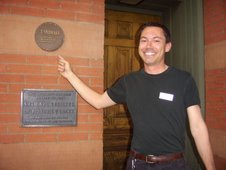Apologies to my regular readers for the delay in posting. I've had an unfortunate computer issue that has now hopefully been resolved. Before that meltdown, I had been working on the little known street called Cheyenne Place. Perhaps you haven't heard of it. It is the last street on the named downtown grid as one goes toward the intersection of Colfax and Broadway. In fact, Cheyenne Place intersects both streets at the extreme southeastern tip of the original congresssional grant that made up Denver City. There were more streets past Cheyenne Place, at least on paper, but they never came to fruition. They had names such as Smith, Dudley, Platte and Saint Charles
Today, the Denver Newspaper Agency dominates the area behind Cheyenne Place on blocks 244 and 267. There is no Block Number associated with the small triangular parcel that sits on the south side of Cheyenne Place. There is no business or street address for Cheyenne Place either. The only thing on Cheyenne Place is the familiar Pioneer Monument, installed in 1910. This statue was designed by Frederick MacMonnies. That's Kit Carson who rides a horse at its top. Originally, the plans called for an Indian to be placed atop. Those plans were scrapped due to the controversial subject matter. The Pioneer Monument is the symbolic end of the Smoky Hill Trail, which brought many early settlers to Denver (something equally controversial to the Indians!).
Prior to that time, there was another building on this site. In fact, it was Denver's first "real" fire station. Here are some pictures of that early time. This building was removed around 1909 as the immediate area began to transform into the Civic Center Park area we know today. The Pioneer Monument was one of the first items to be installed.
This picture from 1910 shows the newly installed Pioneer Monument on the left center side of the photo. The monument was originally on a circular platform. It has since been sitting on a triangular piece of land.
For well over a century, until the Denver Newspaper Agency put its building there, the land on the north side of Cheyenne Place has been dominated by transporation related uses.
And the ultimate in car culture from 1970, the monument is now an afterthought, as it is just a mere neighbhor to the sea of parking behind it. The Arapahoe County Courthouse land is now the Hilton Hotel. This parking lot remained for nearly 25 years until the arrival of the Denver Newspaper Agency. The Pioneer Monument once again appears to "fit in" to its corner on Cheyenne Place, even if its one side facing Broadway is home to one of the city's seedier bus stops.
All historic photos are from the Denver Public Library's Western History Collection.














4 comments:
Thanks for a really great blog!!
Excellent rundown. Palace Stables was on the 1400 block of Pennsylvania, though. AAA was built in the middle of where 15th used to run before it was rerouted for CC park.
It is certainly possible that there was another location for Palace Stables in the 1400 Block of Pennsylvania. However, the picture shown remains at Cheyenne Place, near Broadway, 15th and Colfax, and Palace Stables are clearly marked. The more famous photo taken by William Henry Jackson also shows the Palace Stables in this location. A rerouting of Colfax, AKA 15th Avenue, and not to be confused with 15th Street, did occur a bit to the west of this location however when Civic Center Park was under construction. That is the portion of Colfax and also of 14th Avenue that makes a curve around the park.
I worked for AAA back in the early 1970s. In preparation for the 75th anniversary, I was going through some of the old newsletters and discovered that my great-grandfather, John A. Bell, was the contractor who converted the stables and shop to the first AAA office building. Great to see these old photos of the site!
Post a Comment